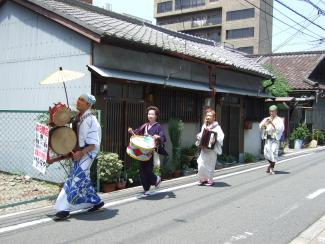Event
“Chindon-ya's Footwork: Walking as a Genealogical Performance on the Streets of Osaka, Japan”
Since its inception in the late 1800s, practitioners of chindon-ya—a Japanese street musical advertisement practice—have often been alluded to as magicians of the city, or likened to the Pied Piper of Hamelin. Ostentatiously dressed, chindon-ya practitioners parade through the streets, not to publicize products themselves, but to lure listeners out of their homes to employers’ establishments through their musical sounds. This presentation explores the logic of enticement in chindon-ya's performance by focusing on the act of walking as a genealogical performance—creative practice of assembling and animating historical times. Against the backdrop of the Street Observation Study movement that became popular in Japan in the 1980s, I offer an ethnographic analysis of an Osaka-based chindon-ya troupe’s kinesthetic and discursive practices to show how the seemingly nonchalant gait of chindon-ya is in fact guided by sonically, aesthetically, and physiologically informed performance tactics grounded in specific senses of historicity and sociality. I suggest that chindon-ya's walking body does the work of what Henri Lefebvre calls rhythmanalysis: creatively listening to social relations as integral to physical surroundings, while making various patterns of temporal organization—biological, cultural, individual, collective, contemporary, and historical—into presences. Understanding chindon-ya's footwork as both an enactment of sedimented histories and a creative process of reconfiguring the spatial dynamics of urban streets, I argue that chindon-ya's performance of enticement emerges from the oscillation between multiple temporalities, particularly within the entanglement of western imperialism and the development of Japanese capitalist modernity that informed the formation of chindon-ya. -Marié Abe
